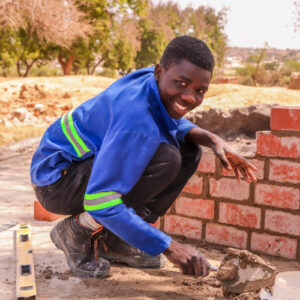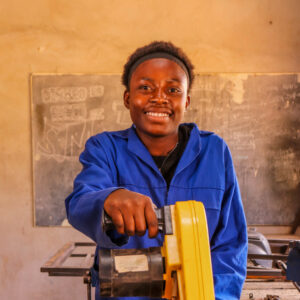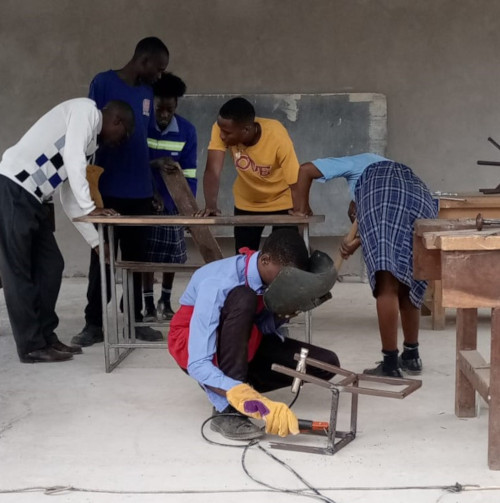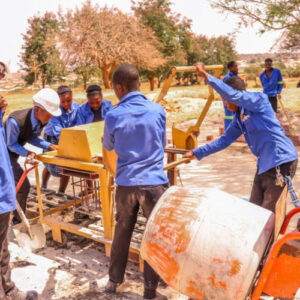We're looking for
Retail Volunteers

Workaid’s partner organisation in Zambia, the Vwila Foundation have formed a strong working relationship with various government departments to support their efforts to provide young people with the best possible vocational training. In a recent interview between Annie Njovu, Head Teacher, Bulungu Secondary School, Mumbwa and Emmanuel Zulu from Vwila Foundation, they discussed the positive impact of the vocational pathway on the young people and local community.


The Secondary school is in Mumbwa district of the Central Province, on the western side 4 km from the town. Currently we have over 90 teachers and close to 3000 learners. The age range of the learners is from 11 to 45. The children are coming from all over, we have some learners coming as far as Nambala, almost 10 km from the school, and they make it on a daily basis starting off around 4 am to reach the school. We also have some learners who come from different districts, and because the school is located in a densely populated area they come and live in small rooms in a boarding house quite near the school which their parents organise. A typical day starts at 6:45 am and we expect all the learners to be in school at 7 am exactly when the lessons start.
At our school, we are offering both academic and vocational career pathways. The vocational career pathway was introduced in 2014/2015 by the Ministry of Education. We started offering the vocational career pathways in 2016. We offer Design and Technology, Home Economics, Agricultural Science and ICT. Learners start as young as 11, when they are in grade 7 and go on up to grade 12.
Almost 50% of the 3000 learners follow the vocational career pathway. We have an average of 80 learners in a class, with six classes in a year grade. For each grade there are three classes for the vocational pathway and three classes for the academic pathway. So, it’s about 50/50. Having 80 learners in one class is quite a challenge. Sometimes we go up to 110 learners in some classes, it’s a big challenge, but we’re trying our best.
Woodwork, metalwork, electrical, bricklaying and design, spray painting, plumbing and construction. It’s a youth training centre!
Vocational training is a practical subject, which requires hands-on activities. So that’s why the infrastructure itself is really critical in this area. We have limited infrastructure, of course but we’re able to offer the services to the learners in a small workshop. We have worked on the storage facility and the strong room with the help of Workaid tools and equipment. We are now working on a small shelter that will help our learners to access lessons.


Yes, very helpful in the sense that the learners, they acquire skills. They’re able to go out there and they set up their own small-scale businesses. Some of them have opened up their own shops and are doing fine. Not every child can manage to go to university and college. The skills they’re gaining from the school means they’re able to take care of themselves and when they leave school, they’re able to sustain themselves. Some learners are joining existing entrepreneurs who are working in the district. In agricultural science, we have young people who are running businesses with small gardens and in construction we have some who have joined the contractors and they end up living there.
Yes, we have a prominent businessman here in the district, he’s one of our former learners. He has already established a business with trucks and he is quite an important person now. He has employed so many young people from our school. In construction, we have some learners who have joined contractors. We have a few through the help of the school who are doing welding and metal fabrication, making window and door frames.
The receiving of the tools is what led to an increase in the number of students taking the vocational pathway of design and technology. We have the majority of learners in that subject because of the help that we received from Workaid. The teaching has been made easier, we really appreciate the donations.
My concluding remarks would be as a school we appreciate the services we are receiving from Workaid. The school wouldn’t have reached the level it has reached without your aid. When you visit our school, you’ll find a lot of activities, especially in the vocational career pathways, even in the home economics department we have a good number of learners there who are doing tailoring.


‘So, we are just saying thank you so much Workaid for being a good partner to the school. You’re not just helping the school, but the community, when the learners acquire the skills they go out there and do things for others, they help the community, they employ others.’ – Annie Nijov
Retail Volunteers
Click or tap the image to read about The Difference We Make in Africa
Click or tap the image to read about the Zambia Appeal Update
Sign Up for our newsletter and information about our work in Africa and in the UK.
Phone Number: 01494 775220
Email Address: admin@workaid.org
Address:
The Old Boot Factory
71 Townsend Road
Chesham
Buckinghamshire
HP5 2AA
Registered Charity: 1041574
The Office
Monday – Friday
9:30am – 12:30pm
1:30pm – 4:30pm
Tool Donations
Monday, Wednesday & Friday
9:30am – 12:30pm
1:30pm – 4:00pm
The Workaid Shop
Thursday, Friday & Saturday
10am – 4pm
The Hub
Monday & Tuesday
10am – 3pm
Phone Number: 01494 775220
Email Address: admin@workaid.org
Address:
The Old Boot Factory
71 Townsend Road
Chesham
Buckinghamshire
HP5 2AA
Registered Charity: 1041574
The Office
Monday – Friday
9:30am – 12:30pm
1:30pm – 4:30pm
The Workaid Shop
Thursday, Friday & Saturday
10am – 4pm
Tool Donations
Monday, Wednesday & Friday
9:30am – 12:30pm
1:30pm – 4:00pm
The Hub
Monday – Tuesday
10am – 3pm
Phone Number: 01494 775220
Email Address: admin@workaid.org
Address:
The Old Boot Factory
71 Townsend Road
Chesham
Buckinghamshire
HP5 2AA
Registered Charity: 1041574
| Cookie | Duration | Description |
|---|---|---|
| cookielawinfo-checkbox-analytics | 11 months | This cookie is set by GDPR Cookie Consent plugin. The cookie is used to store the user consent for the cookies in the category "Analytics". |
| cookielawinfo-checkbox-functional | 11 months | The cookie is set by GDPR cookie consent to record the user consent for the cookies in the category "Functional". |
| cookielawinfo-checkbox-necessary | 11 months | This cookie is set by GDPR Cookie Consent plugin. The cookies is used to store the user consent for the cookies in the category "Necessary". |
| cookielawinfo-checkbox-others | 11 months | This cookie is set by GDPR Cookie Consent plugin. The cookie is used to store the user consent for the cookies in the category "Other. |
| cookielawinfo-checkbox-performance | 11 months | This cookie is set by GDPR Cookie Consent plugin. The cookie is used to store the user consent for the cookies in the category "Performance". |
| viewed_cookie_policy | 11 months | The cookie is set by the GDPR Cookie Consent plugin and is used to store whether or not user has consented to the use of cookies. It does not store any personal data. |